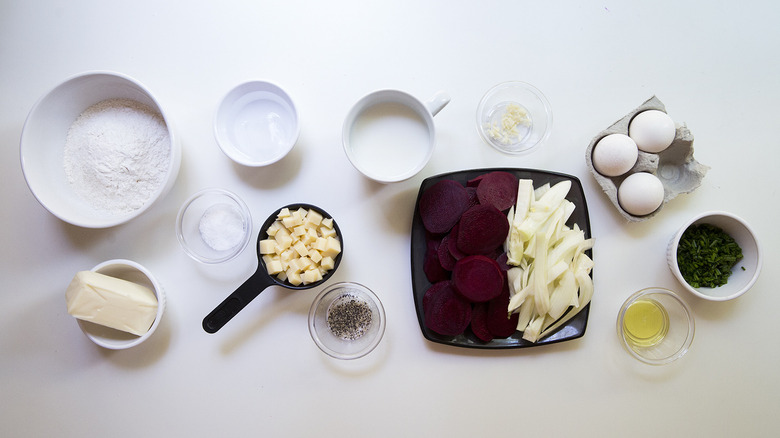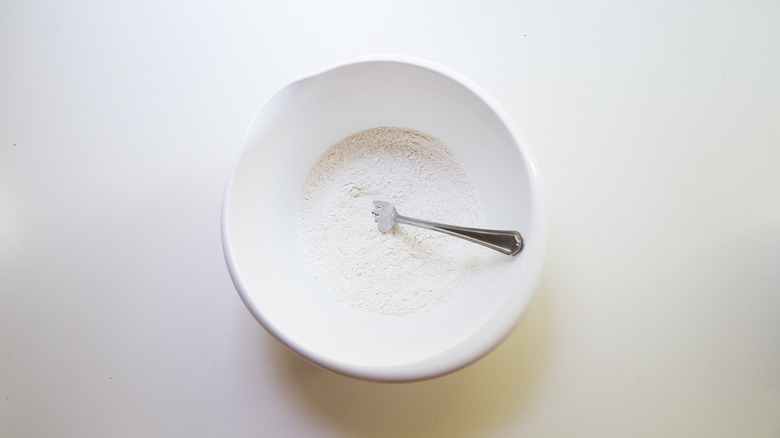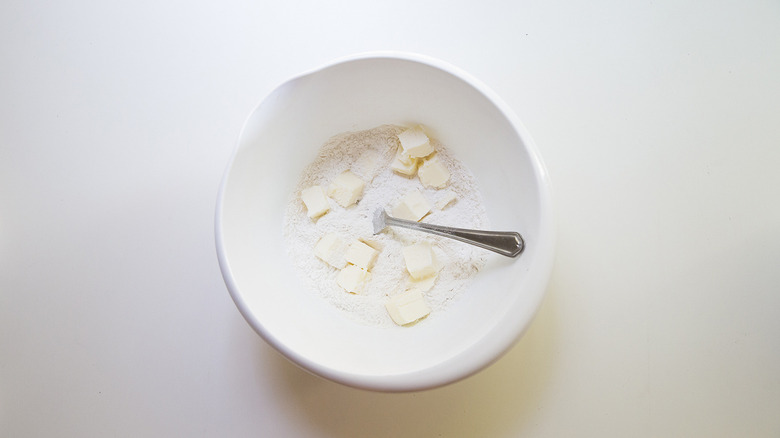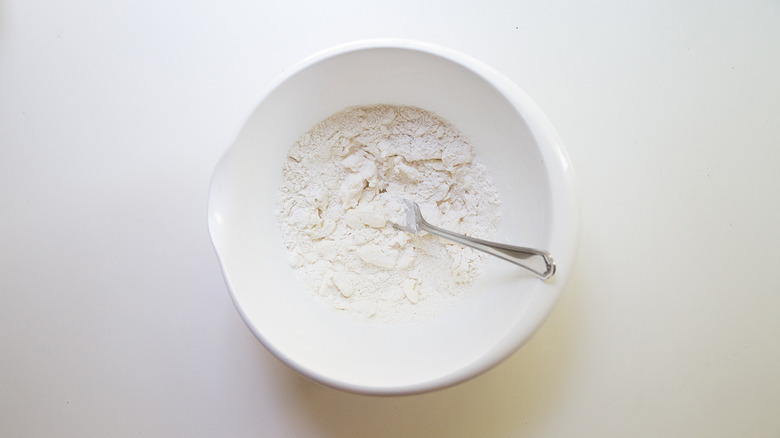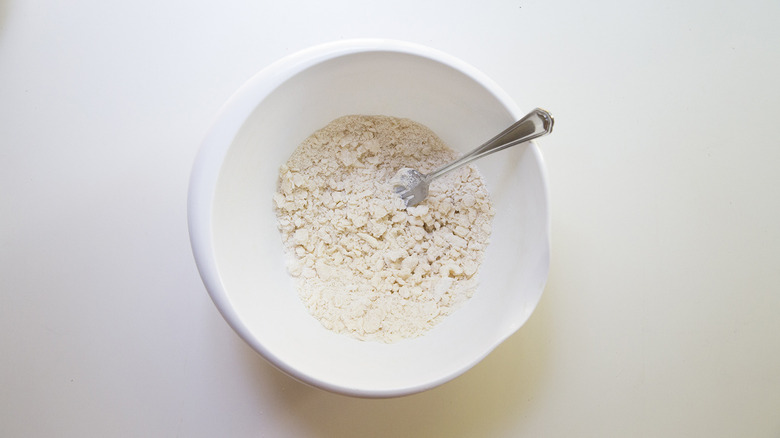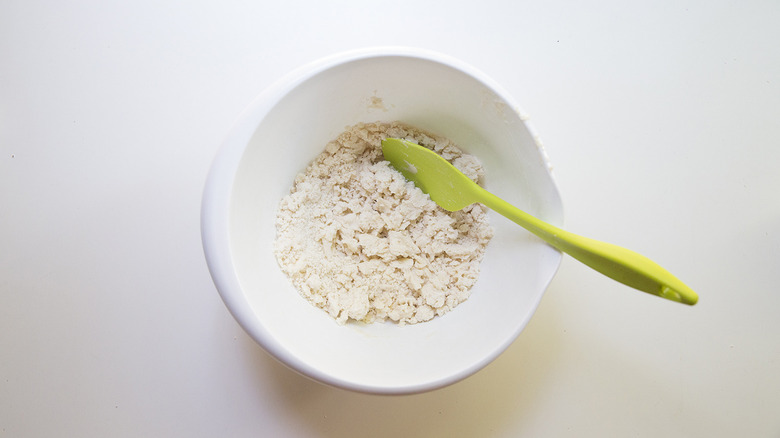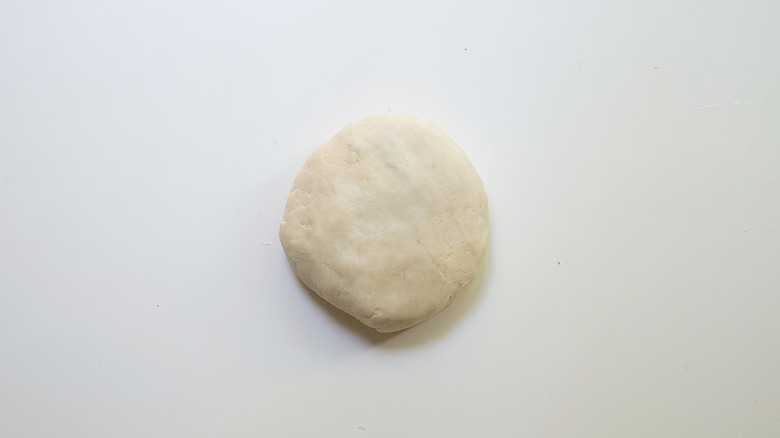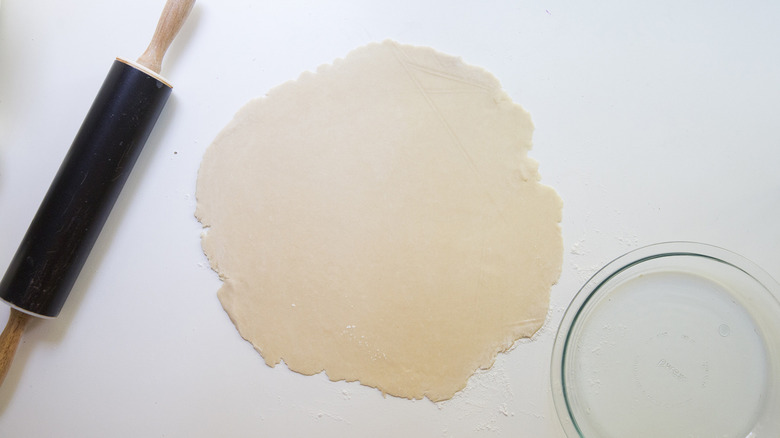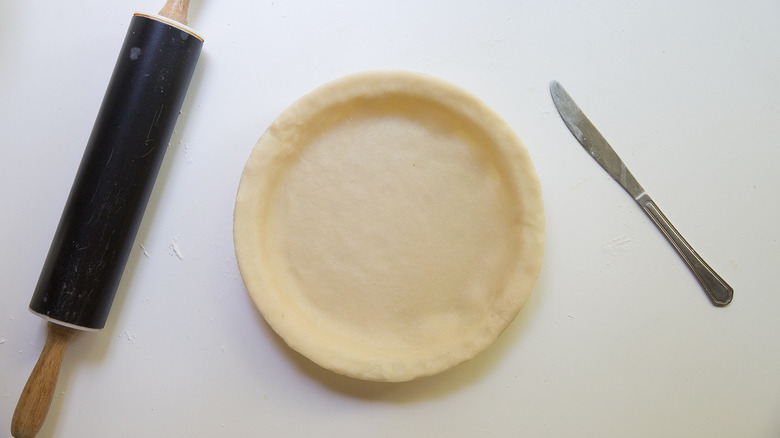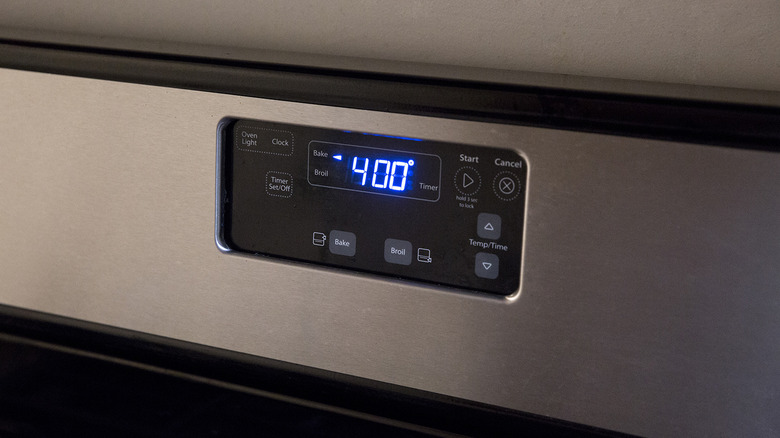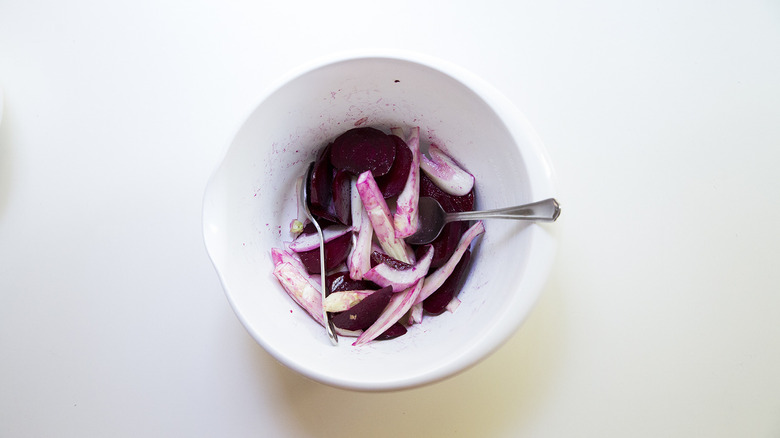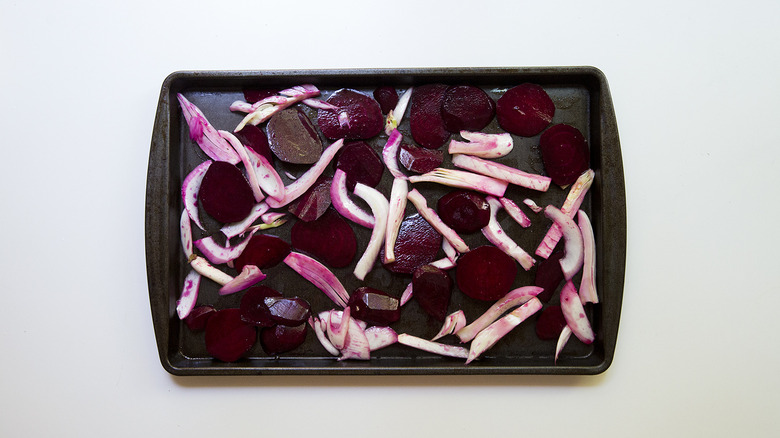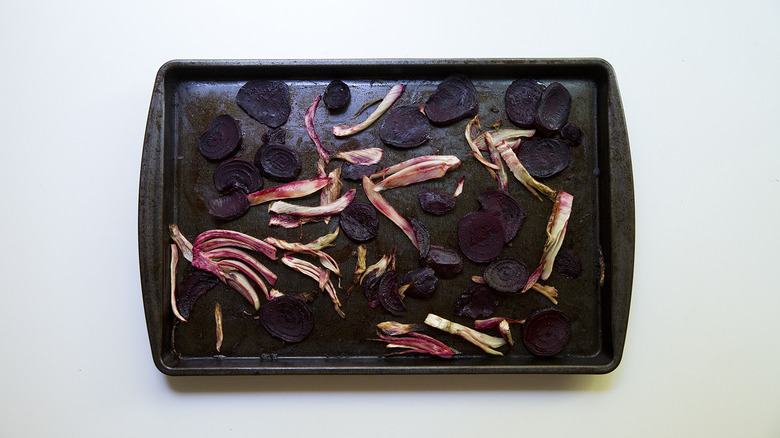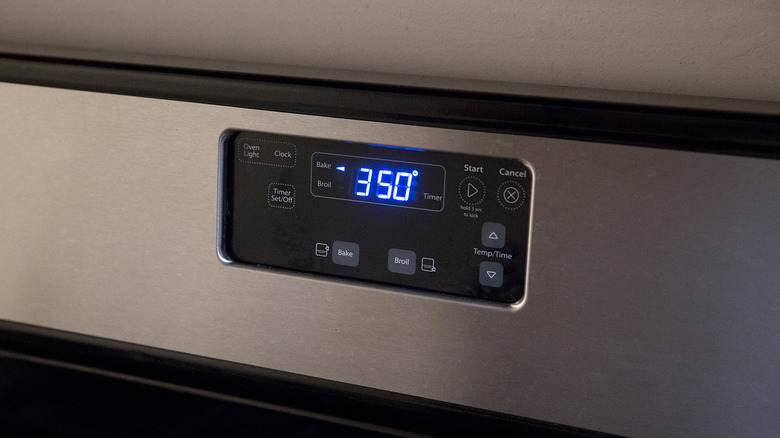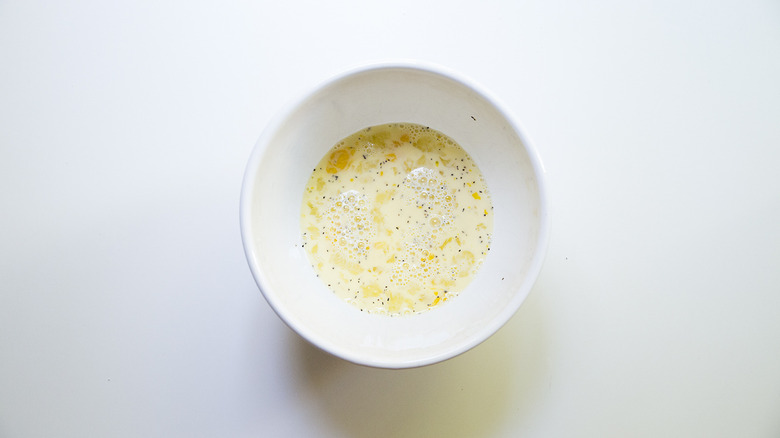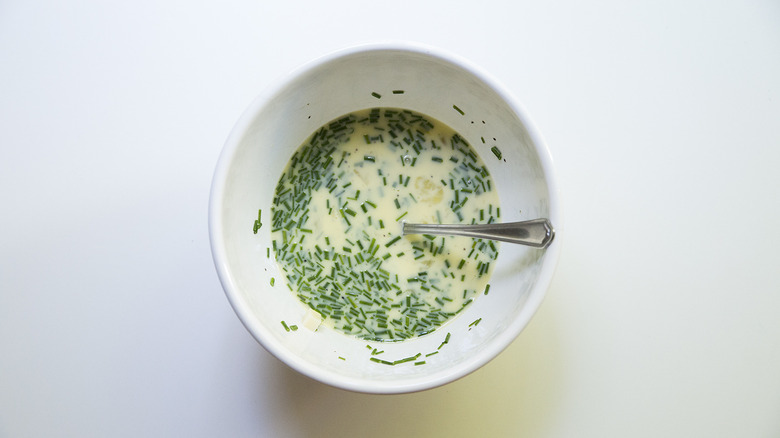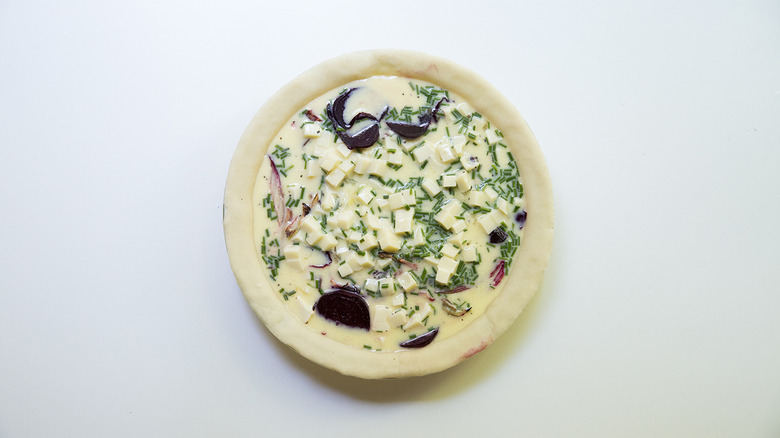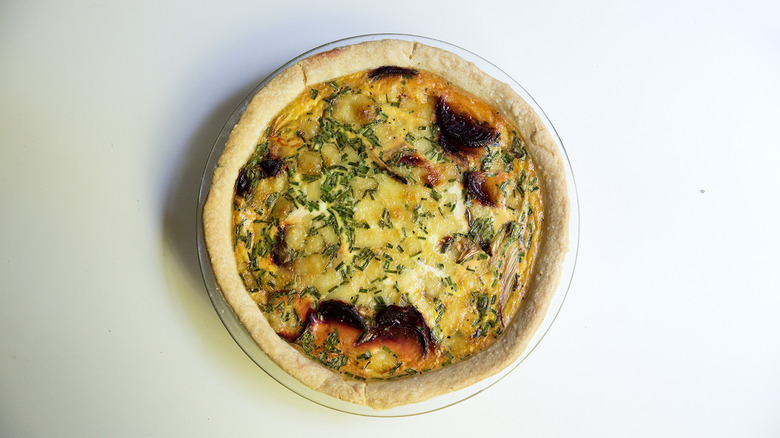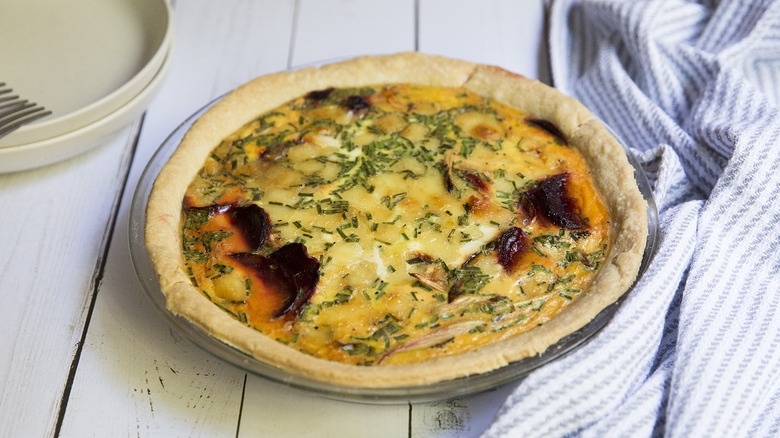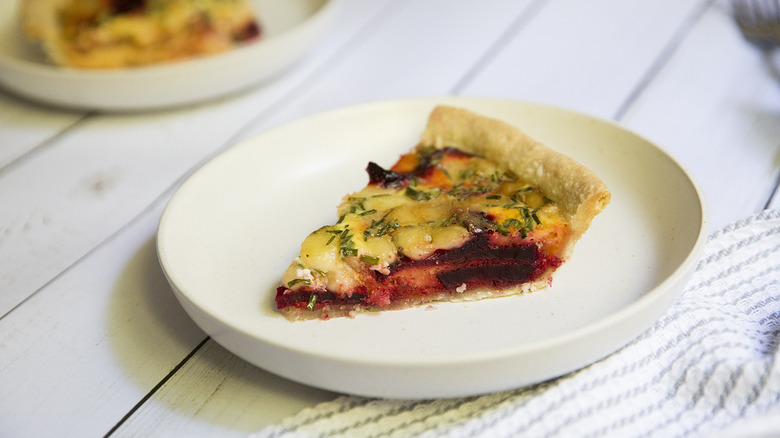Roasted Beetroot And Emmental Quiche Recipe
Quiche became popular in the United States in the 1970s and 1980s, with the French quiche Lorraine, made with eggs, cream, and bacon, probably the most famous version. While the name and associations are French, quiche actually dates back to medieval Germany. Which was also France, kind of. The region in question alternated between German and French hands for hundreds of years. The Germans called it Lothringer and the French, Lorraine. The dish, Lothringer speckkuchen, which means bacon cake from Lothringer, gave way to the word quiche in French (from the kuchen part, of course). The dish stuck around, and today there are countless ways to combine the egg and cream base with different vegetables, herbs, cheeses, and meats.
Recipe developer Michelle Bottalico has created a recipe for a roasted beetroot quiche that features roasted fennel, chives, and Emmental cheese. Bottalico explains the origin of her idea: "This quiche was inspired by an Italian savory tart that comes from the Northern Alpine regions. The original dish pairs beets and potatoes with celery and garlic, and I've always found it delicious. Instead of celery, I wanted to use fennel to compliment the beets, and I decided to roast both of the vegetables." She's happy with the way it turned out. "While beets and fennel are each delicious when roasted on their own, the combination is extra fun and works well with all the other ingredients."
Gather your roasted beetroot quiche ingredients
The first part of this recipe is making the pie crust. You will need all-purpose flour, salt, unsalted butter, and ice water. It's important that the butter is cold, so don't let it sit out beforehand. The ice water is important too, because it helps keep the dough cool when you're handling it and rolling it out. For the roasted vegetables, you will need 3 small beets and a large fennel bulb.
The other ingredients are olive oil, more salt, pepper, large eggs, whole milk, garlic, Emmental cheese, and fresh chives. Grated Parmesan is an optional ingredient, but it adds a stronger cheesy flavor and an additional salty touch to the finished dish, since Emmental has a mild flavor.
Step 1: Start making the pie crust
To make the pie crust, first place the flour and salt in a large mixing bowl and whisk to combine.
Step 2: Add the butter
Cut the cold butter into ½-inch-square pieces and add them to the bowl. Make sure the butter has come straight from the refrigerator.
Step 3: Start cutting in the butter
Use a fork or pastry cutter to start pressing the butter into the flour.
Step 4: Finish working the butter
Continue until all the butter is coated in flour and the mixture is crumbly with very small pieces of butter still intact. Work quickly to avoid the butter melting too much.
Step 5: Add the water
Add 2 tablespoons of ice water and mix with a spatula until the dough starts to stick together. Add more ice water 1 tablespoon at a time only if it's too dry. Don't add too much or it will get tough. It's ready when the dough sticks together when pinched.
Step 6: Form a ball
Quickly gather and shape the dough into a flattened ball with your hands, without kneading it.
Step 7: Roll out the dough
Transfer the dough ball to a lightly floured work surface and roll it into a 13-inch circle. Flip and lightly dust with flour if it sticks. If the dough sat out too long and is too soft or sticky to roll, refrigerate it until firm.
Step 8: Line the pie pan
Center the dough over a 9-inch pie pan, pressing it lightly onto the bottom and sides of the pan. Cut off any excess dough hanging over the edge. Refrigerate for at least 30 minutes until ready to use.
Step 9: Preheat the oven
For the roasted vegetables, first preheat the oven to 400 F.
Step 10: Season the vegetables
Place the beets and fennel in a large mixing bowl, add olive oil and salt, and toss to coat the vegetables evenly.
Step 11: Transfer to a baking sheet
Spread the vegetables in a single layer on a large baking sheet.
Step 12: Roast the vegetables
Roast for 30-40 minutes until tender, flipping the vegetables halfway through the cooking time. Remove from the oven and set aside.
Step 13: Adjust the oven temperature
Lower the oven to 350 F.
Step 14: Whisk the egg mixture
Place the eggs, milk, garlic, salt, and pepper in a large mixing bowl and whisk to combine.
Step 15: Stir in the remaining ingredients
Stir in the Emmental and chives as well as the optional Parmesan, if using.
Step 16: Assemble the quiche
Remove the pie pan from the refrigerator, arrange the roasted vegetables at the bottom, and pour the egg mixture on top.
Step 17: Bake the quiche
Place the pan in the oven with a baking sheet below in case of spillage and bake for 55-65 minutes until the center is set and the top is lightly browned.
Step 18: Serve the roasted beetroot and Emmental quiche
Let the quiche cool for at least 15-20 minutes before serving.
Roasted Beetroot and Emmental Quiche Recipe
A simple flaky and tender pie crust is filled with earthy and flavorful roasted beets and fennel and combined with nutty Emmental cheese in this elegant quiche.
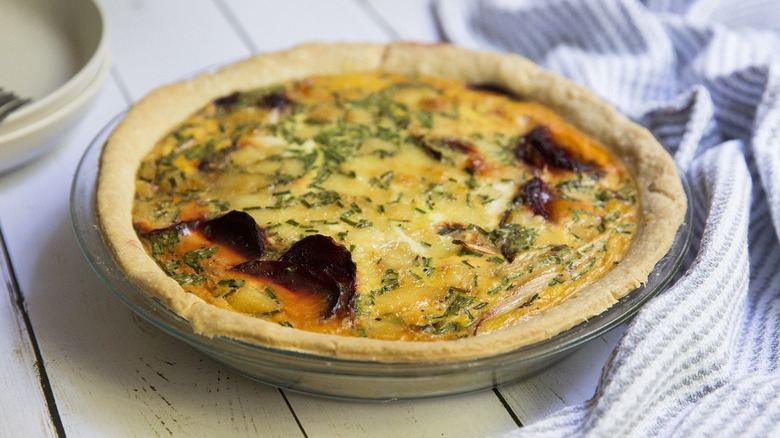
Ingredients
- 1 ¼ cups all-purpose flour
- ½ teaspoon salt
- 8 tablespoons cold, unsalted butter
- 3 tablespoons ice water
- 3 small beets, peeled and sliced into ¼ inch pieces
- ½ large fennel bulb, sliced into ¼ inch pieces
- ½ tablespoon olive oil
- 1 pinch salt
- 3 large eggs
- 1 cup whole milk
- 1 clove garlic, minced
- ½ teaspoon salt
- ¼ teaspoon pepper
- 1 cup diced Emmental
- 3 tablespoons chopped chives
Optional Ingredients
- ¼ cup grated Parmesan
Directions
- To make the pie crust, first place the flour and salt in a large mixing bowl and whisk to combine.
- Cut the cold butter into ½-inch-square pieces and add them to the bowl. Make sure the butter has come straight from the refrigerator.
- Use a fork or pastry cutter to start pressing the butter into the flour.
- Continue until all the butter is coated in flour and the mixture is crumbly with very small pieces of butter still intact. Work quickly to avoid the butter melting too much.
- Add 2 tablespoons of ice water and mix with a spatula until the dough starts to stick together. Add more ice water 1 tablespoon at a time only if it's too dry. Don't add too much or it will get tough. It's ready when the dough sticks together when pinched.
- Quickly gather and shape the dough into a flattened ball with your hands, without kneading it.
- Transfer the dough ball to a lightly floured work surface and roll it into a 13-inch circle. Flip and lightly dust with flour if it sticks. If the dough sat out too long and is too soft or sticky to roll, refrigerate it until firm.
- Center the dough over a 9-inch pie pan, pressing it lightly onto the bottom and sides of the pan. Cut off any excess dough hanging over the edge. Refrigerate for at least 30 minutes until ready to use.
- For the roasted vegetables, first preheat the oven to 400 F.
- Place the beets and fennel in a large mixing bowl, add olive oil and salt, and toss to coat the vegetables evenly.
- Spread the vegetables in a single layer on a large baking sheet.
- Roast for 30-40 minutes until tender, flipping the vegetables halfway through the cooking time. Remove from the oven and set aside.
- Lower the oven to 350 F.
- Place the eggs, milk, garlic, salt, and pepper in a large mixing bowl and whisk to combine.
- Stir in the Emmental and chives as well as the optional Parmesan, if using.
- Remove the pie pan from the refrigerator, arrange the roasted vegetables at the bottom, and pour the egg mixture on top.
- Place the pan in the oven with a baking sheet below in case of spillage and bake for 55-65 minutes until the center is set and the top is lightly browned.
- Let the quiche cool for at least 15-20 minutes before serving.
Nutrition
| Calories per Serving | 410 |
| Total Fat | 27.4 g |
| Saturated Fat | 15.3 g |
| Trans Fat | 0.2 g |
| Cholesterol | 158.2 mg |
| Total Carbohydrates | 27.4 g |
| Dietary Fiber | 2.4 g |
| Total Sugars | 5.3 g |
| Sodium | 461.4 mg |
| Protein | 14.1 g |
Can I substitute ingredients in this quiche?
Quiche is a versatile dish that can be made in countless flavor combinations. The ingredients in this beetroot quiche can be substituted according to what you have on hand or if you would like to tweak the flavor according to your taste. First of all, it wouldn't be a beetroot quiche without its namesake ingredient, but there are other popular root vegetables that can be tasty in a quiche. Turnips, rutabaga, parsnips, celeriac, sweet potato, and carrots all work either in addition to or instead of beets.
Emmental is a unique Swiss cheese with large holes and a mild, slightly nutty flavor. If you can't find it or you're looking for a way to finish a different cheese that's sitting in your refrigerator, you can substitute it with other similar cheeses like Gruyère, Fontina, Havarti, Jarlsberg, and Gouda or other mild cheeses like Brie.
Fresh herbs are the secret to upgrading a quiche, and it's hard to go wrong. This recipe uses chives, but many other herbs would be just as delicious. Whether you reach for basil, rosemary, tarragon, parsley, or thyme, you'll add a unique herby touch that really brings the dish together. Finally, instead of whole milk, you can opt to use a lower fat milk, or for extra creaminess, half and half or heavy cream.
Can I make beetroot quiche ahead of time?
While this recipe includes a homemade pie crust, roasted vegetables, and a moderately long baking time, don't let the process scare you. If you're short on time, want a quick weeknight dinner option, or are prepping several dishes at once for a gathering like a party or brunch, it can be more convenient to make at least part of this dish ahead of time.
While you could opt to purchase a store-bought pie crust, another option is to make the dough in advance, roll it out, place it in the baking dish, and refrigerate it for up to two days. Make sure to wrap it tightly in plastic wrap so it doesn't dry out or absorb odors.
Roasting the vegetables ahead of time is another good way to save time, as is doing other prep work like cubing cheese and chopping herbs. Then just assemble the quiche and bake before serving. You can also assemble the whole quiche ahead and refrigerate it for up to 24 hours before baking, but consider blind baking the crust first so it doesn't get soggy. This just means that you partially bake the crust first so it dries out a little. The last option is to bake the quiche ahead of time and reheat it before serving, although we think it doesn't taste as fresh this way.

